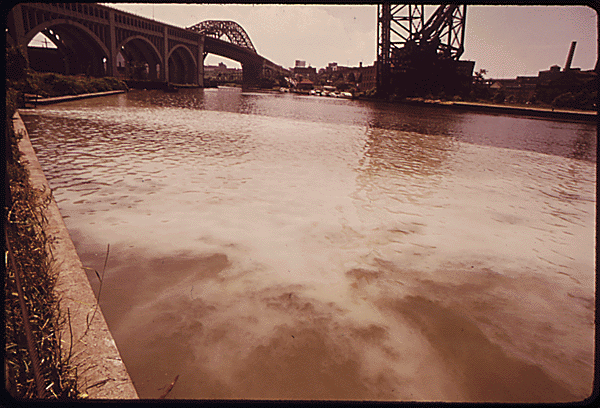Federal Water Mandates Blowing a Hole in Municipal Budgets, Local Leaders Say
Local government officials and utility leaders ask U.S. Congress to invest in water projects and to provide regulatory flexibility. The framework is part of a broader debate about how to balance ecosystems, public health and financial constraints, in this, the 40th year of the Clean Water Act.

By Brett Walton
Circle of Blue
If not for a few well-placed bolts, segments of the Washington, D.C., sewer system would have blown apart at the seams recently during fierce rainstorms and subsequent flooding in the nation’s capital.
“The hydraulic pressure of all the flow is so great it is popping off the manholes and shooting them in the air,” said George Hawkins, general manager of the District of Columbia Water and Sewer Authority.
For obvious safety reasons, city workers locked down the manhole covers — but doing so caused sewer lines to back up into homes and businesses, reversing the flow of the fetid blend into basements and stockrooms.
The primary culprit is inadequate capacity in the pipes. The trunk sewer and the feeder lines that serve the district’s Bloomingdale neighborhood were built at the turn of the 20th century.
“They simply are not big enough to contain the flow that goes into the system, which is handling both stormwater and wastewater,” Hawkins told a House Transportation and Infrastructure subcommittee on July 25.
–George Hawkins, general manager
D.C Water and Sewer Authority
Replacing the line would cost $US 600 million, Hawkins said. And though water-quality agreements with the U.S. Environmental Protection Agency (EPA) do not require that that project be taken up, the city is carrying out $US 3.6 billion in water-infrastructure projects that do have a federal mandate.
Because of these mandates, many communities and ratepayers are “economically tapped out,” said Representative Bob Gibbs (R-Ohio), the chairman of the subcommittee on water resources and environment.
New Approaches Needed
Hawkins and six other local government officials were witnesses for a Congressional hearing about the EPA’s new integrated planning framework for stormwater and sewers. Two EPA administrators testified on a second panel.
The integrated framework lets communities shuffle the sequence of water-quality projects, allowing the most beneficial improvements to be pursued first. The framework is part of a broader debate about how to balance ecosystems, public health, and financial constraints, in this, the 40th year of the Clean Water Act.
The landmark piece of legislation — passed by Congress in 1972 over then President Richard Nixon’s veto — has significantly reduced water pollution from factories and wastewater-treatment plants, facilities that dump chemicals and organic matter from the end of a pipe.
So-called nonpoint sources of pollution — the fertilizer-saturated runoff from farm fields and the flush of street grime that comes from rainstorms in cities and towns — have been much tougher to curb and now comprise the largest slice of the pollutant pie.
Nearly everyone agrees that new approaches to clean water are needed, approaches that give better results at lower cost. A policy established in 1997 for controlling overflows from sewers that carry both sewage and stormwater has proven astronomically expensive, running into the billions of dollars for many cities.
The new thinking on sewer infrastructure includes:
- Natural systems, called “green infrastructure,” to take advantage of the storage capacity in soils and wetlands.
- Sponge-like paving materials, which, unlike non-porous cement and asphalt, soak up rainwater.
- Better coordination between water and sewer authorities, which are typically segregated, and better management of infrastructure assets.
- New forms of financing, from both public and private sources.
The discussion on July 25, however, turned quickly to the heavy financial burden that federally mandated sewer projects often bring, especially now, as many people are still reeling from the Great Recession and as the cost to control the final units of pollution increases exponentially.
“We are doubling the percentage of low-income D.C. residents who are unable to pay their bills or are stressed by paying their bills,” Hawkins said of the rate increases brought by the water-infrastructure expansion.
–Representative Timothy Bishop (D)
1st District of New York
Under prior pollution permits, the D.C. sewer authority reduced nitrogen discharges at a cost of $US 15 per pound. Now that the easy sources have been eliminated, the authority is spending more than 30 times as much —$US 476 per pound — to cut a much smaller amount of pollution. Nancy Stoner, the EPA’s acting assistant administrator for water, told the committee that green infrastructure can be a cost-effective way to reduce these marginal sources of pollution.
Step Up to the Plate
According to Hawkins, one in three dollars spent in D.C. goes to water projects. But, as bad as that seems, the situation is arguably worse in southwest Ohio.
Todd Portune, a commissioner for the Hamilton County, Ohio, Board of Commissioners, told the committee that the county budget has been cut by 35 percent since 2007. This creates a “bizarre reality,” he said, in which the budget for the sewer district ($US 380 million in 2012) is nearly double the budget for the entire county ($US 207 million), largely because of federally mandated projects.
“Where is the balance in this approach — or the fairness?” Portune asked. “What do I tell my constituents when they ask why I am forcing them to pay more for sewer repairs each year than I raise from all other revenue sources for all other county operations?”
Representative Timothy Bishop of New York, the subcommittee’s ranking Democrat, said that communities expect Congress to “step up to the plate.” Then he went on to acknowledge that “we have taken no action on renewing the federal financial commitment to wastewater infrastructure this Congress.”
Lead and Serve
The primary federal vehicles for water and wastewater investment since the 1980s have been the state revolving funds, two low-interest loan programs administered by the states. After a surge in funding, thanks to the federal stimulus in 2009, allocations to the programs have consistently declined each year.
In early July, the House Appropriations Committee approved an EPA budget with steep cuts to these state revolving funds.
Loans, however, must be repaid — and with interest. David Berger, mayor of Lima, Ohio, told the committee that more debt does not help his community.
“The local pocketbook is very finite,” Berger said. “If the Congress has passed these as mandates and as orders for us to execute, then you must join us to pay for it. If the cash isn’t there or the political will isn’t there, then [regulatory] relief must come.”
Some witnesses appealed to the nation’s history of federal investment in clean water and wastewater treatment.
“The United States marked the 20th century with breakthroughs and investment in water infrastructure that helped lift our nation to international prominence for the past 100 years,” said Ralph Becker, mayor of Salt Lake City, Utah. According to the U.S. Conference of Mayors, of the $US 82 billion spent on water services and infrastructure in 2005, 99 percent of water supply costs and 95 percent of sewer costs were picked up by local governments.
So, even a generous federal contribution will not move the needle all that much.
“We ask you to lead and serve your people,” Becker continued, “by addressing the underlying issue of aging infrastructure and unmet infrastructure needs. This effort will set our local communities, our states, and country up to meet the challenges and opportunities of leading the world into the next century.”
Brett writes about agriculture, energy, infrastructure, and the politics and economics of water in the United States. He also writes the Federal Water Tap, Circle of Blue’s weekly digest of U.S. government water news. He is the winner of two Society of Environmental Journalists reporting awards, one of the top honors in American environmental journalism: first place for explanatory reporting for a series on septic system pollution in the United States(2016) and third place for beat reporting in a small market (2014). He received the Sierra Club’s Distinguished Service Award in 2018. Brett lives in Seattle, where he hikes the mountains and bakes pies. Contact Brett Walton








Until we elect representatives and hire public employees to public office willing to prioritize funds for maintenance of existing infrastructure verses spending the funds on expansion of existing facilities in hope of new development and as political playoffs to their supporters no progress in this area will be made. The ever increasing debt and likely future inflation will only increase the amount needed to address this issue. Therefore, the answer appears to be vote out and fire the current bureaucrats and replace them with more fiscally responsible ones.